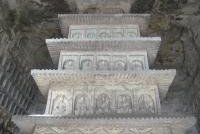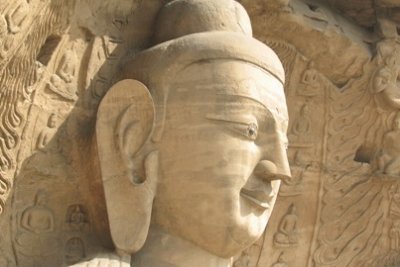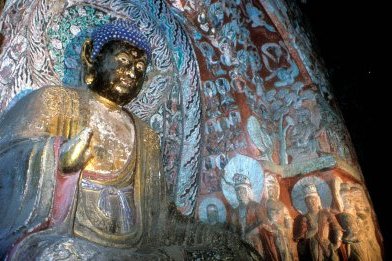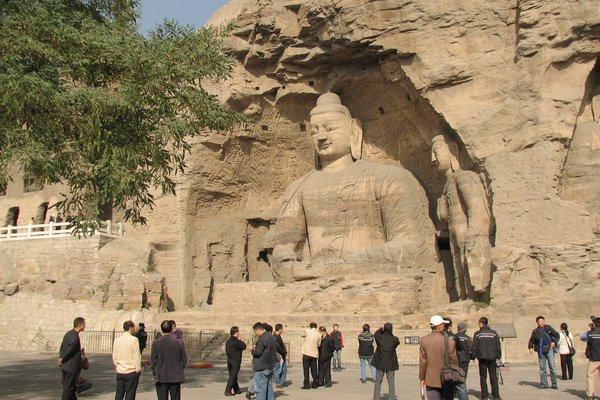China
Yungang Grottoes
The Yungang Grottoes are excellent examples of early Chinese Buddhist cave art.
The 53 caves with 51,000 carved statues were excavated in the south face of a sandstone cliff. They were created during the Northern Wei Dynasty (386-534), whose emperors introduced the 'foreign' Buddhism and turned it into their state religion.
Community Perspective: The grottoes are easily visited from the city of Datong, and present a virtual art laboratory where “ancient artists acted like scientists who made experiments to assimilate South and Central Asian arts into local arts”. Frederik laments its location among dusty industrial coal mine complexes, but that was in 2009 (it was already that way in 1978 when Solivagant visited) – we need a more recent review of what it looks like now!
Site Info
Official Information
- Full Name
- Yungang Grottoes (ID: 1039)
- Country
- China
- Status
-
Inscribed 2001
Site history
History of Yungang Grottoes
- 2001: Inscribed
- Inscribed
- Type
- Cultural
- Criteria
- i
- ii
- iii
- iv
Links
- UNESCO
- whc.unesco.org
- Official
-
- yungang.org — Yungang Grottoes
All Links
UNESCO.org
- whc.unesco.org — whc.unesco.org/
Official Website
- yungang.org — Yungang Grottoes
News Article
- Dec. 23, 2017 scmp.com — Chinese engineers make life-size replica of World Heritage Site by using 3D printer to recreate Yungang Grotto
- May 3, 2009 news.xinhuanet.com — Anti-seeping project approved for Yungang Grottoes
Community Information
- Community Category
- Religious structure: Buddhist
Travel Information
Beijing hotspot
Recent Connections
-
Marco Polo
Visited Yungang Caves while in Datong, … -
Perfect Inscriptions
2001 -
World Monuments Watch
Buddhist Grottoes of Maijishan and Yung…
Connections of Yungang Grottoes
- Individual People
-
-
Marco Polo
Visited Yungang Caves while in Datong, and wrote about it; Marco Polo praised Datong's weapons manufacturing industry and the Yungang Grottoes.
-
- Trivia
- History
-
-
Located in a Former Capital
Datong was the capital during Northern Wei Dynasty (386-493) -
Silk Roads
Eastern Route; "Buddhism arrived in this location via travel on the ancient North Silk Road" (wiki)
-
- Architecture
-
-
Rock Cut Architecture
"The grottoes were excavated in the south face of a sandstone cliff" (wiki) -
Wooden architecture
-
- World Heritage Process
-
-
Perfect Inscriptions
2001
-
- Religion and Belief
-
-
Pagoda
Stone carving pagodas in caves 1 and 21
-
- Constructions
-
-
Giant Buddha statues
One of 16.8 meters and one 13.5 meters in height
-
- WHS on Other Lists
-
-
World Monuments Watch
Buddhist Grottoes of Maijishan and Yungang, China (2025)See www.wmf.org
-
- Timeline
-
-
Built in the 5th century
"They are an outstanding example of the Chinese stone carvings from the 5th and 6th centuries. All together the site is composed of 252 grottoes with more than 51,000 Buddha statues and statuettes." - wiki
-
- WHS Hotspots
-
-
Beijing hotspot
Train from Beijing North or Qinghe is just 2 hours and very frequent. From Datong South Railways Station, you can take shared taxi for 30 min to the Grottoes or public bus for 2 hours (need to transfer in Datong city center)
-
News
- scmp.com 12/23/2017
- Chinese engineers make life-size r…
- news.xinhuanet.com 05/03/2009
- Anti-seeping project approved for …
Recent Visitors
Visitors of Yungang Grottoes
- Alejandro Lau
- Alexander Lehmann
- Alex Goh
- Ali Zingstra
- A. Mehmet Haksever
- Ammon Watkins
- Ansitong
- Artur Anuszewski
- Aspasia
- Atila Ege
- Bamse
- basementonline
- Bernard Joseph Esposo Guerrero
- Bill Koo
- Bill Maurmann
- Bin
- Boj
- Bram de Bruin
- chenboada
- Christravelblog
- Claire Bradshaw
- Daniela Hohmann
- David Marton
- Dimitar Krastev
- Dr. Caligari
- Dwight Zehuan Xiao
- Els Slots
- Erik Jelinek
- Fan Yibo
- Federico P.
- Frederik Dawson
- George Gdanski
- GeorgeIng61
- Harald T.
- Harry Mitsidis
- henryjiao18
- heywhatever2
- Iain Jackson
- Jeffrey Chai
- Jens
- JoshHad
- Joyce van Soest
- jxrocky
- Karito Vies
- Kasper
- Ken DJ
- Knut
- KoenigMarke
- Kristin
- Kurt Lauer
- Lameduck99
- lichia
- Ludvan
- Luke LOU
- Maciej Gil
- Maciej Gowin
- Matthewsharris
- MaYumin
- MichaelH
- Michael Turtle
- Miloš Tašković
- Monica Tasciotti
- Morodhi
- nan
- Nihal Ege
- PabloNorte
- Patrik
- Pchxiao
- PeterH
- Petteri
- Philipp Peterer
- Remski
- Reza
- Risson
- Rob Wilson
- Rubbie
- Sandra!
- Sergio Arjona
- sibariam
- Sijia
- Solivagant
- Ssong.x
- Stanislaw Warwas
- Taotao Chen
- Thomas Buechler
- Thomas van der Walt
- trekkie900
- Vanessa Buechler
- Walter
- wantrain.
- Weecheng
- Westwards
- Xander Huang
- Xiong Wei
- Xiquinho Silva
- Yang Chengyu
- Yongcheng Liu
- Zhou Yan
- Zoë Sheng
- Zos M
- ZZSong
Community Reviews
Show full reviews
After Wutai Shan, I continued my Shanxi journey to the city of Datong, one of the ancient capitals of China and where my second world heritage site of this trip, Yungang Shiku or Yungang Grottoes which roughly translated as cloud ridge caves located. Before coming to Datong, I had heard many reports on how dusty and ugly city was, but even prepared to be open minded, Datong was quite exactly what I heard, and the worst of all was its smell, whole city smelled like a burning coal.
Since the grottoes were almost 20 kilometers from the city center, I decided to hire a taxi for whole day to take me there. My driver took me pass a few large coal mines, then he turned right in one junction and use a very new road that cut though a truly waste zone of nothing, and then suddenly I was in front of the large dusty construction site and with surprised the driver told me that "we finally arrived Yungang Shiku!" Reluctantly to admit, Yungang were the worst World Heritage Site in terms of its location as it was in the middle of ugly and dusty industrial coal mine complexes.
After paid a reasonable price of 60 Yuan for a ticket, I entered another wonderland of hundreds of grottoes. In my opinion, Yungang was one of the greatest laboratories of art in the whole world; this was the place where for almost 70 years ancient artists acted like scientists …
Keep reading 0 comments
Dusty and dry Datong sees a fair number of western visitors due to its location relatively close to Beijing and because it's the first stop in China of the Trans-Mongolian Express. This medium-sized city has a couple of sights, of which the Yungang Grottoes are the most worthwhile. Bus 3-2 plies the 15 km from the train station and the city center to the grottoes.
It's a bit difficult to see the carvings in their right chronological order. After entering, you end up in cave 6, which is one of the most brightly painted and represents the 'Chinese' phase. Even the ceilings are full of little details. The neighbouring caves also are colourful and lively, like early versions of the Dazu rock carvings.
Walking westwards, I arrived at the five caves of the first phase. These are huge, solemn Buddha statues looking out from a window on the second floor. When you walk into the cave, you only see their legs.
Finally, I walked back to the eastern caves (1-5). Be sure not to miss these ones. Especially Cave 3 is interesting, as it is the largest cave of all. There are only 2 statues inside, but you can walk inside and enjoy the play of sunlight and shade.
My visit lasted about 2 hours, enough to take in all the major caves in detail and walk around once more to take it all in from a distance. After having visited Dazu and Longmen, I think …
Keep reading 0 comments
My 4th and final review of Buddhist caves/grottos on the UNESCO list in China has reached Yungang near Datong (ref reviews of Mogao, Longmen and Dazu).
This too was visited by me as early as 1978. However for some reason or another it has registered less in my mind than Longmen, visited just a few days earlier. Perhaps the novelty of looking at Buddhist statues had worn off or perhaps I was still recovering from having, earlier that morning, visited the “Anti-Nuclear Tunnels” at a cake factory in Datong! There we had been told that Mao Tse Tung had said in his teachings on preparation for war and natural disasters “Dig tunnels deep, stock greens (vegetables?) everywhere and never seek hegemony” (there is no answer to that!). So the 335 workers in the factory had spent 4 years working in their spare time without payment to dig 1500 metres of tunnel. These they showed us with understandable pride. They had created kitchens, dormitories, meeting rooms and a “cleaning room” for nuclear, chemical and biological agents - and still had plans for more!! Somehow the futility of this human endeavour cast a shadow on the results, albeit more beautiful, resulting from effort, but possibly equally futile, spent carving out and painting over 50000 Buddha statues in nearby cliffs at Yungang!! There our guide had told us that the temples were the result of the “Exploiting classes of former rulers who used Buddhism to imprison people’s minds” - but this seemed …
Keep reading 0 comments
